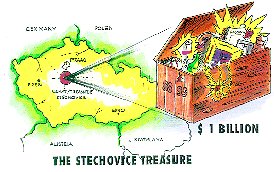In April of 1945 parts of the Czech Republic were one of the last battlefields of WW-II. Under the command of General
Schorner, one million German soldiers feared for a harsh treatment from the Red Army led by Field Marshal Konev, so
they started moving south to surrender to the approaching American Army. At that same time Martin Bormann and Gestapo
Leader Heinrich Müller (members of Hitler’s inner circle) implemented final plans to rescue what was left of the collapsing
empire in the hope that someday a Fourth Reich would rise in South America (ODESSA). Under supervision of Otto Skorzeny
(Hitler's own James Bond), top secret archives and stolen war booty were transported from Berlin to Czechoslovakia.
An authenticated document from the Military Archives in Prague states that on 21 April 1945 K.H. Frank (German's Supreme
Commander in the occupied Czechoslovakian Republic) received a telegraph message from Berlin headquarters with the order
to redirect a closely-watched cargo train to a safe place outside Prague. On 22 April 1945, Frank met with Emil Klein at
the Czernin Palace in Prague and ordered Klein to transport the crates (temporarily stored in the palace`s cellars) to
Hradistko. One of Frank’s personal servants (Günther Aschenbach ) later confessed that he supervised delivery of at least
56 crates from the SS base at Konopiste Castle to the area of Hradistko. After the hiding only Günther Aschenbach and Emil
Klein knew from the whereabouts as all other possible witnesses, SS personnel and the concentration camp inmates, were
assumed to have been assassinated.
In February 1946 while Czechoslovakia was fully under Soviet occupation, the U.S. Military Command in Germany (USPET)
dispatched a Special Intelligence Unit on a raid deep into Soviet occupied territory near Prague, to excavate Klein's
hidden boxes. The Mission existed of ten American and two French intelligence officers stationed in Nürnberg.
Lionel S. B. Shapiro, a correspondent of the North American Newspaper Alliance (NANA) was the only civilian in the group.
Later he wrote that the find included- K.H. Frank’s daily journals (1940-1945) - Gestapo reports from the same period -
a list of 60-70,000 Czech Nazi collaborators - guidelines for secrecy measures used during German research projects -
and a complete inventory list of all significant Czech antiquities and state treasures, including the coronation artifacts
from ancient Czech(oslovakian) kings.
With assistance of Major Charles Katek, head of the U.S. Military Mission in Prague, they asked the Soviets permission
to recover the body of an American pilot shot down over Stechovice during the war. On the 10th of February 1945 they
received a two-week-long permit to enter the Czech Republic. The team was headed by Captain Stephen M. Richards, one of
the U.S. Army’s most experienced explosive experts and by captured POW Günther Aschenbach.
During a rapid 36 hour operation, which took place between 11 and 12 February 1946, the special commando located one of
the bunkers on Aschenbach’s directions. After dismantling an complicated explosive system they excavated 32 crates.
The crates measured approx 100 X 80 X 70 cm, each 180 kilos, which later became known as 'The Prague Archives'.
Photographs of this secret mission show members lifting wooden boxes from a snow-covered bunker, loading them into
trucks were published in many newspapers around the world. When three of the officers were discovered by Czech police
on the night following the operation, the crates were already transported into the American controlled zone in Germany.
The three American officers were arrested and held until 3 March 1945. Following a sharp protests from the Czech
government, 31 crates were ultimately returned to Prague and one was kept by the Americans. That is why it is believed
that the most valuable part of the documents remained in American hands and more intriguing, what happened with the other
24 boxes Klein and Aschenbach burried?
Whatever it is, truth or fantasy, the Stechovice Treasure kept attracting the attention of various people and organisations
from around the world but Emil Klein, key to the mystery of the 24 missing crates, kept silent. According to
Czechoslovakian interrogators, he refused to co-operate in spite of severe physical and psychological torture. Every
time when he was escorted to the former SS pioneer camp in Hradisko he would only draw another false complex plan.
After his release to West Germany in December 1964 Klein shared his secrets with a person called Helmut Gaensel, the
author of The Prague Connection, who arranged Klein’s release from Czech imprisonment. Perhaps coincidence but this
release followed immediately after the discovery of 15 steel boxes at the bottom of Black Lake near the Czech-German
border in 1964. They boxes contained SS documents, describing in detail Hitler’s assassination plots against several
European political leaders.
In June of 1968, Hollywood director John Guillermin filmed some of the key scenes ‘The Bridge at Remagen’ in Stechovice.
He chose an area close to the bunker where the US Commando Team found The Prague Archives in 1946. Many sources speculate
that the C.I.A. financed the location shootings enabling undercover agents who figured in the movie, to search the
remaining 24 crates the Special Intelligence Unit did not find in 1946.
In the fall of 1989 Czech weapon exporter Omnipol and a team of American scientists from a so-called Jet Propulsion
Laboratory in Pasadena, CA, started a project in the Hradistko Hills to excavate the lost 24 crates Emil Klein and
Günther Aschebach hid in 1945. A few weeks after Vaclav Havel was inaugurated as President of the Czech Republic
suddenly all activities were stopped and Mr. Jakes Jr, the project leader (and son of the Communist Party’s General
Secretary) fled to Germany.
|
